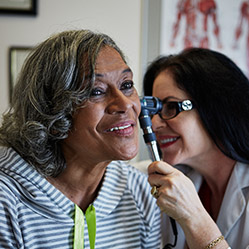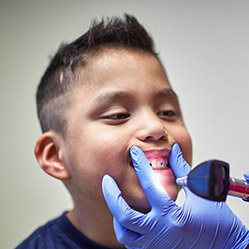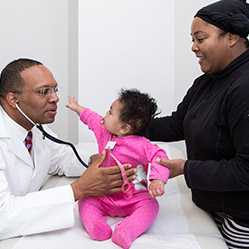
Many roadblocks keep patients from getting health care. Maybe a facility does not take a patient’s insurance. Perhaps the patient does not have transportation to get to and from the health clinic. A majority of providers only open from 9 to 5, during peak work hours for many.
Northern California’s OLE Health recognizes these obstacles within its community. So in order to ensure equitable access to quality care to residents across Napa and Solano counties, the staff venture outside of OLE’s health clinics and into the region — into vineyards, homeless shelters, parks, and community centers — to help patients get the care they need.
That dedication to patient care is what caught the attention of Capital Impact. In fact, when OLE Health expanded from Napa to Solano County — a region with different needs and new demographics — Capital Impact supported that expansion with $1 million in financing from its California Primary Care Association Ventures loan program. This new location allows OLE to continue to fulfill its mission of meeting patients where they are.
This series of photographs tells the stories of several doctors and patients whose lives are positively impacted by the vital services OLE provides through its innovative approach.
We invite you to click the circles below each set of pictures to view the entire series.
ENSURING EQUITABLE ACCESS THROUGH ON-SITE HEALTH FAIRS
-
About 15 years ago, the OLE team noticed that Napa’s farmworkers — the 6,000 or so workers who produce the region’s famous wines — were not getting the care they needed. Since many workers send money to their families in Mexico, they did not want to miss a day’s worth of wages, so they often skipped valuable preventative care appointments.
As a result, many waited until they were extremely ill before finally seeing a doctor. Some seasonal workers didn’t know their options for health care as immigrants, so they put off seeing a doctor until they went back to Mexico, often spending months in pain.
-
OLE Health, which was founded as Clinica OLLE (Organizacion Latino Americana de Liberacion Economica) in 1972 to provide care for Napa’s low-income, uninsured, and Spanish-speaking agricultural workers, knew it had to do something. So the OLE staff started going to farmworkers — at vineyards and farmworker housing centers. Clinic workers offered free health screenings in the evenings — so patients didn’t have to miss work — and provided education about healthy habits, dental care, and common chronic illnesses. The staff also gave referrals to OLE’s clinics for any further care.
-
First launched at its health clinics, OLE also started incorporating its signature “warm hand-offs” into the screenings, where medical providers who identify mental or behavioral health issues introduce patients to behavioral health specialists during their appointments so they can plan for further treatments.
-
Today’s fair is one of the many that OLE hosts yearly in conjunction with wineries throughout the region. The lineup of resources at events, which range from legal advice to alcohol and drug rehabilitation information, is the direct result of feedback from farmworkers.
-
“Many of these farmworkers, even though they have insurance because their employers offer it to some of them, still are not accessing care. This health exam today is the only one they probably had within the last several years,” says Patrisia Contreras-Vigil, OLE’s patient services manager. “It's really important to us to ensure the economic vitality of our community as well by making sure the workers that support the valley’s economy are healthy.”
-
On another weekend, Contreras-Vigil spends her Saturday morning at a health fair in downtown Fairfield, California — an hour north of San Francisco and just a few miles away from OLE’s newest facility. She is spreading the word about OLE’s services and the variety of ways people can connect with them. Over the years, OLE has turned to on-site health fairs and other innovative approaches to broaden its reach. The goal is to help as many patients get the care they need.
-
“One of our missions is to go [to] patients when and where they need the care,” says Contreras-Vigil. “It's important that we go out there to accommodate a patient or a community member at the time that they need care — that they do not necessarily have to come into the health center but that we can meet them where they are.”
PROVIDING HOUSING AND HEALTHCARE FOR VINEYARD WORKERS
-
Angel Calderon, a former farmworker, was out walking around Napa with his family a few years ago when he noticed a group of men walking toward a bridge. When he followed them, he discovered that the men — all farmworkers for nearby wineries — were homeless and lived under that bridge surrounded by waste. Many farmworkers don’t have a place to call home due to the region’s high rents and lack of affordable housing. Horrified, Calderon began working with vintners to create housing for the region’s seasonal workers.
-
Now, Calderon runs the River Ranch Farm Workers Housing Center, one of Napa’s three farmworker housing centers, which hold 60 workers each. For $14 a day — and a pay stub proving they work at one of the farms or vineyards — workers get a bed in the tidy dorms and three hearty meals.
-
Workers spend their days picking grapes or grafting grape vines. It’s hard, physically demanding work. The high-end wines produced in Napa that sell for hundreds of dollars require that the grapes be hand harvested as opposed to harvesting with machines. And when they’re done for the day, health care is often the last thing on their mind. So OLE introduced a program to visit them at housing centers like the one Angel runs.
-
For the center’s residents, many of whom suffer from work-related issues such as back pain, sun damage, and conditions associated with agricultural chemicals, OLE’s twice-yearly visits may be the only chance they’ll get to see a doctor. After they receive a physical, farmworkers get referrals to other OLE facilities if needed.
-
“OLE’s been helping since I remember. They have been very, very involved with the farmworker community,” says Calderon. “They take care of them. Clinic OLE is cheaper than any of the other hospitals. And the people over there are pretty open to the farmworkers, so they feel comfortable.”
Calderon also appreciates that OLE’s team speaks Spanish. “When somebody speaks our own language, we feel more comfortable,” he says. “Speaking English, especially medical terminology, is complicated. At Clinic OLE, almost everybody speaks Spanish.”
-
Jose, a vineyard worker living at the shelter, was surprised by the range of services offered at OLE’s event. In addition to a medical team, there were representatives from the police department and immigration offices.
“I came to do a medical check
up, and they sent me to Clinic OLE to see a doctor to do more tests, and he gave me a routine physical. It was a positive experience,” Jose says. -
Without OLE’s visits Jose would most likely go without health care.
“Latinos aren’t accustomed to going to the doctor unless they’re really sick,” Jose says with a shrug and smile. “If it weren’t for this, we wouldn’t have a checkup or any medical visits.”
DELIVERING QUALITY CARE FOR NAPA’S HOMELESS RESIDENTS
-
While OLE started as a resource for farmworkers, in the 1980s it expanded to help all of Napa’s vulnerable populations, a practice it still continues. Every Tuesday a team of three providers from OLE Heath — a doctor, behavioral health specialist, and physician’s assistant — finishes their day and heads to South Napa Shelter for their second shift. It’s one of two Napa homeless shelters in which OLE has a permanent space, and its services are in high demand, with a constant line of patients eagerly awaiting care.
-
Like its other efforts OLE does not just focus on physical health care; it also helps people acquire transportation to other clinics and provides nutrition advice or dental care, if that is what a patient needs. During the visit, if the doctor identifies a behavioral health issue, she’ll call in the behavioral health specialist, who will visit with the patient and then refer him or her for further treatment at OLE if necessary. OLE prioritizes a whole-body approach to health, and the behavioral health specialist is part of that puzzle, helping to address underlying mental health issues — an especially vital service in a place like the shelter, where the majority of residents struggle with addiction issues.
-
“What we do is the same model we try to offer at OLE Health [clinics], which is try to assess the psychosocial stressors or difficulties that they’re going through,” Diana Montes, a behavioral health specialist who works at the shelter, says of the patients there. “The biggest issues we see are drug and alcohol problems. There is a lot of PTSD in this community because they have been living on the streets, and there are many traumatic experiences that they’re exposed to — violence, rape, and those types of things.”
-
Chris is 56 and has been homeless for about ten years. When Chris lived on the streets, he turned to alcohol to numb the pain. He appreciates OLE’s whole-body approach to health.
“In order for you to get off the street and into housing, you got to have physical health and mental health going at the same time,” Chris says. “Otherwise, if you have one without the other, then you’re going to wind up back out on the street anyway.”
-
These kinds of traumas can lead to emotional sessions, but over time, patients have come to trust the providers at OLE. During her appointment with shelter resident Cheryl, Montes listens as Cheryl describes her past negative experiences with doctors and her fears about being thrown in jail. Montes takes it all in, listening intently, murmuring comforting words and passing a tissue when necessary.
-
“You have our support. You know that, right?” Montes says.
“I know that with all my heart,” Cheryl, a resident of the shelter, responds.
“There are times that I’ve been bitchy and mad and angry, but they’ve never turned me away,” Cheryl says of her experience with OLE. “They never shamed me."
“They have the heart,” Cheryl continues. “I recommend all my friends, everybody that I meet, I say, ‘If you need help, go to Clinic OLE. They are there. They don’t bullshit you. They don’t lie to you. They don’t promise you stuff that they can't keep. If they can help you, they would do whatever they can.’”
-
Jacky, a 23-year-old mother of five who talks in rapid-fire fits and starts, agrees. “I really don’t go to hospitals. I don’t like them. I’ve had bad experiences in them,” she says. “But OLE helps me not be so afraid because they like to help.
“Before I came to the shelter I wasn’t really taking care of myself. I have very bad lung issues and heart problems,” Jacky continues. “When I’m there, they make me feel safe — I don’t have to worry about being scared to open up about what’s up with my health. They basically say, ‘It’s OK; talk to us. Tell us about your body. We’ll learn from you.’”
-
It’s a long day for Montes and her team. While the hours at the shelter are supposed to be from 6 to 9 p.m., they usually stay until 10 or 11 to ensure they see every patient. But it’s worth it, she says, because she knows what would happen if they didn’t make these visits.
“They wouldn’t have anything. They wouldn’t have behavioral health. They wouldn’t have the medical provider. I think they would be really ill without us,” Montes says. “I can’t even imagine these patients without the services that we provide, to be honest. They are really grateful for us, and we’re really grateful for them because they’re amazing.”
CREATING A MEDICAL SAFETY NET FOR FOSTER YOUTH
-
A few miles away from the South Napa Homeless Shelter, Dr. Lynette Leighton, a family medicine physician at OLE, prepares to see patients at VOICES. The downtown Napa community center helps young adults transitioning out of the foster care system. At the center, 16- to 24-year-olds can participate in a variety of programs to help them learn skills, ranging from housing readiness to college preparation. They also receive the health care they need from OLE, which partnered with VOICES in 2008.
-
Leighton and her team work at VOICES once a month. Seeing her or her team members provides a low-stress, comfortable experience for the youth there. Instead of schlepping across town to a sterile doctor’s office, the young adults can simply stop whatever they’re doing at the moment — whether that’s creating their first resume or playing video games with friends — and walk down the hall to get care.
Leighton enjoys it, too: “It’s my favorite day of the month, every month,” she says.
-
“That ability to easily get care is vital,” says Leighton. She points to the fact that many patients here require certain procedures that dramatically affect their health and quality of life. But they don’t receive it because the procedure is only offered at OLE’s St. Helena location, a 20-mile journey from Napa to St. Helena. Traveling that distance is a real barrier for a lot of patients.
“Some people don’t know how to navigate the medical system, or they don’t have transportation, but they all gravitate to this center,” Leighton says. “It feels good to bring the medicine they need to the place where they’re already hanging out.”
-
Twenty-one-year-old Rhys, an ex-staffer at VOICES who’s gone through the center’s program, likes the fact that Leighton has been a consistent presence there over the past four years.
“The reason I like going to VOICES and going to Clinic OLE is that it gives me a sense of warmth,” he says. “It makes me feel more accepted because I’m around people I know versus going to a doctor’s office, not knowing anybody, and just having that uncomfortable feeling where I don’t know anybody,” he adds. “Switching doctors so many times in my life, I want to stick with one doctor where I’m comfortable. I don't have to keep telling my story.”
-
Randall, 21, is another ex-VOICES staffer. He had a similar experience with OLE. “They were very understanding. They met me on my level,” he says. “They were very welcoming, asked me how my day was going. You could feel the genuineness of it all. They really cared about how I was doing.”
-
“The doctors are super nice,” says 21-year-old Julio. At one appointment, Julio Obando asked questions about topics unrelated to the issue he was being seen for: “What is a metabolism? How could he tell if he had a fast or slow one?”
“They went above and beyond to answer my questions,” Julio says. “I felt welcome and comfortable. I didn’t have that fear or embarrassment. I just felt more open.”
-
Seventeen-year-old Pablo is a frequent visitor to Leighton’s exam room. “I tend to get injured a lot,” he says with a laugh. He likes going to OLE at VOICES because of the atmosphere. “When you go to the doctor’s office it’s boring, you have to wait in long lines, you have to check in — you have to do all these different things,” he explains. “Here, while you’re waiting, you can come and hang out with other people, you can play games, you can get something to eat. You can do all these different things, and it’s more relaxed.”
When Pablo fractured his foot, he came to VOICES. Leighton sent him to get X-rays and pain medication from the main OLE clinics and told him to send her an email once he got to the hospital to update her on how everything went. “It wasn’t just: Tell me where to go and send me on my way and that was it. She wanted to know what was going on, and she also gave me a call once the results came in,” Pablo says. “From then on, I felt like there was not only a work connection but also a personal connection.” -
It hasn’t always been easy for Leighton to gain the trust of her patients at VOICES. Many have spent their lives bouncing around various institutions — foster care, courts, sometimes juvenile hall. They don’t trust the system, and they don’t always trust adult authority figures. She’s worked hard to make her exam room a safe, trusted space.
One of her patients had an older sister that was using meth. The older sister refused to see anyone at one of OLE’s traditional clinics, but the younger sister trusted Leighton so much she convinced her sister to see the doctor at VOICES. “She came in, and we were able to help her get into a rehab situation where she could actually address that issue,” Leighton says. “That felt great because she would not have gone anywhere else — a big clinic or anywhere, really — to get help.”
LEARN MORE ABOUT OUR WORK
Health Care For San Francisco’s Vulnerable Residents
Create Health Care
Impact with Us
Interested in Community Health Center Financing?






























